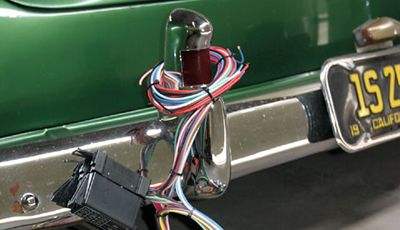
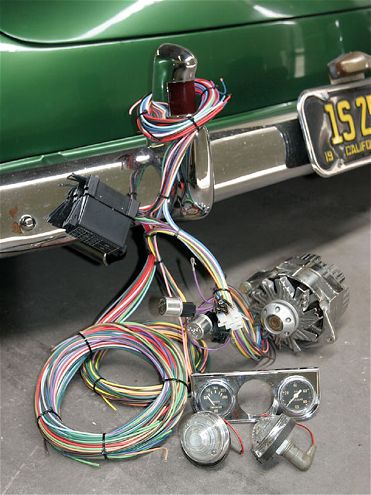
If you turned the page, saw the pictures, and had a mild panic, don't. Sure, we're going to be dealing with electricity, or more specifically the current draw of the various electrical systems in your car, but i'll explain it in simple terms. And there's a good reason for that; I'm not comfortable around electrickery myself, so if I can understand what i've gleaned from experts in the field, you should be able to as well.
So just what is current draw? Every electrical component draws a certain amount of current, which is the measurement of the flow of electric charge, and you need to ensure your charging system can supply enough current to operate everything, from basics like head and taillights, to stereo systems, power windows, and electric fans. There's a very simple formula that can be used to determine the current required by a component: current = power voltage. So, if an amplifier, for example, is rated at 500 watts (power) and your electrical system produces 13.8 volts (the average output for most cars), the current draw will be 500 13.8 = 36.2 amperes, or amps for short. This means that amplifier alone will draw just over 36 amps! However, many components you'll use in or add to your vehicle's electrical system won't have a power rating readily available, but the following table should help:
Current (amp) Draw Dash gauges 2-4 amps Brake lights 3-8 amps Turn signals 4-8 amps Driving lights 3-10 amps Headlights (each) 3-10 amps Spotlights (each) 5-10 amps Radio, CD players 3-7 amps Audio amplifiers 15-{{{300}}}+ amps Electric fans (each) 6-30 amps CDI ignition 6-40 amps HEI ignition 6-10 amps Electric fuel pumps 7-15 amps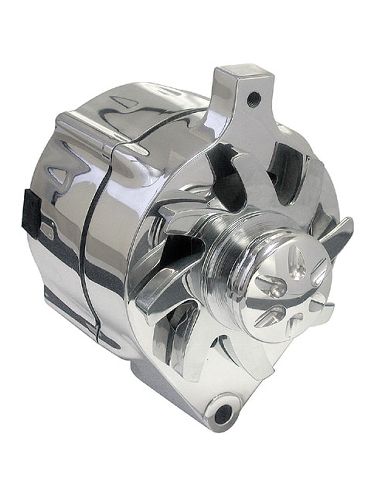 powermaster's bolt-on early model upgrade for Fords comes in one- or three-wire operation. The 100A version produces 70A at idle, with the 140A version kicking out 80A at idle.
powermaster's bolt-on early model upgrade for Fords comes in one- or three-wire operation. The 100A version produces 70A at idle, with the 140A version kicking out 80A at idle.
Using this table, and using the higher estimates, an HEI-equipped car with an electric fuel pump and electric fans, but no stereo equipment or spotlights, will require more than 100 amps on the rare occasions that every electrical system is running simultaneously. Obviously that's way more than will actually be needed, as we used the highest possible amperages, but it's better to build a safety factor into any system.
Pretty obviously, when an engine isn't running, the battery will power any accessories that are switched on, but the alternator charges the battery and simultaneously powers the accessories once the engine is running. No current is supplied by the battery when the current draw doesn't exceed the charging capacity of the alternator, but current is supplied by both the alternator and the battery when an accessory, or a number of electrical systems at once, draws more current than the alternator can produce, which drains the battery, possibly causing starting problems later. If you've ever had an alternator go bad, and carried on driving, it's the battery that was providing the power, until that drained and the engine stalled.
Stock cars are equipped with electrical charging systems that are more than adequate for their electrical systems, but adding accessories with large current draws, such as that 36-amp amplifier for instance, could overload a small system. More appropriately in R&C, when wiring a car from scratch, or even adding to an existing wiring harness, it's important to ensure the charging system is adequate for the number of electrical systems the car will contain, especially in this age of power everything and communications systems. This means an alternator of sufficient charging capacity and a battery of sufficient size and condition.
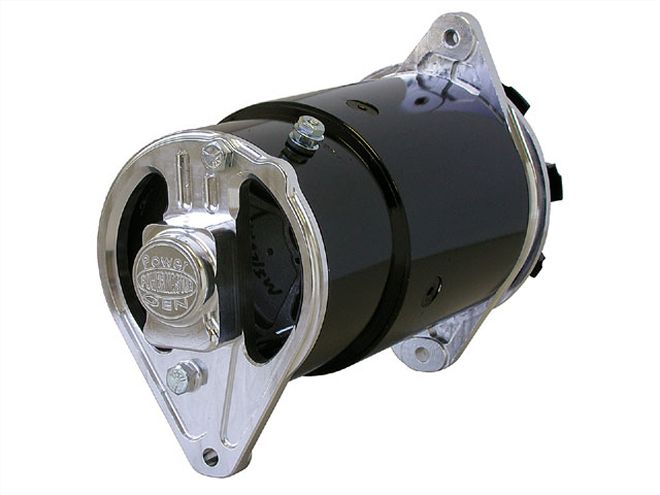 New from powermaster is a powerGEn for Chevys up to '64. As with the Ford version, it is rated at 75A with 60 at idle, is one-wire operation, and features a heavyduty regulator.
New from powermaster is a powerGEn for Chevys up to '64. As with the Ford version, it is rated at 75A with 60 at idle, is one-wire operation, and features a heavyduty regulator.
Choosing An Alternator
We spoke with the guys at powermaster motorsports, who probably provide more specialist alternators than anyone else. Known more recently for their powergen alternators that look like generators, popular with the nostalgic crowd, the company also produces circle track and other race alternators, as well as numerous Ford-, Chevy-, Jeep-, and mopar-specific units-both-high performance oem-replacement and custom. They also manufacture a vast starter motor range, too; all of which means they know a thing or two about alternators and charging systems.
The consensus when it came to selecting an alternator was that first the continuous amp load of the vehicle should be determined, in much the same way as we did previously using the chart. Of course, there is more equipment that isn't in that chart, such as air conditioning or heaters; power windows, seats, and doors; plus any power-operated systems for opening or closing hoods, trunks, or even glovebox doors. Once current draw has been determined, choice of alternator comes down to whether you want one-wire or OE wiring. Incidentally, if you've heard the myth that one-wire alternators do not produce power at idle, that's exactly what it is-a myth. All streetduty powermaster alternators provide the most amps at idle of any alternator on the market, no matter how they're wired. Of course, the final choice comes down to style, and whether you want a chrome or polished finish, or Oem style, but that's irrelevant to us here.
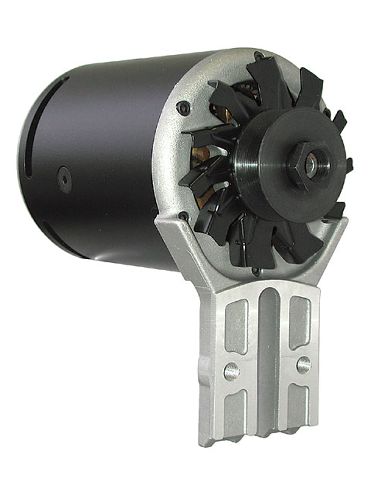 The powerGEn to fit Flathead Ford V-8s is a 75A unit, providing 60A at idle, and with one-wire operation. With a heavy-duty regulator, it's slightly larger than a stock generator, but looks the part and keeps traditional rods looking, well, traditional.
The powerGEn to fit Flathead Ford V-8s is a 75A unit, providing 60A at idle, and with one-wire operation. With a heavy-duty regulator, it's slightly larger than a stock generator, but looks the part and keeps traditional rods looking, well, traditional.
There are also some other points to consider when selecting an alternator, in particular the drive pulleys that determine the speed at which the alternator spins. The maximum speed is around 18,000 rpm, though maximum output is reached at about 6,000 rpm, and spinning faster doesn't increase the output. The optimum speed is between 2,400 and 6,000 rpm according to powermaster, with the greatest efficiency at the lower end of that range. Given that an alternator generally runs at three times the engine speed, sometimes a larger pulley may be required to control the speed at which the alternator turns.
If you were wondering whether a higher-amp output alternator will harm your existing battery or charging system, it shouldn't, as increased amps aren't harmful, though higher voltage would be.
Battery
It's vitally important that you select a battery of sufficient size and amperage to work with your electrical system. To do this you'll need to know a few things about batteries. You may have heard of amp hours, a rating that tells how much amperage is available when discharged evenly over a 20-hour period. Divide the amp hour rating by 20, so a 75-amp hour battery will carry (75 20 =) 3.75- amp load for 20 hours before dropping below 10.5 volts, the level at which it is considered fully discharged and needs recharging. A battery rated at 55 amp hours will carry a 2.75-amp load over the same period.
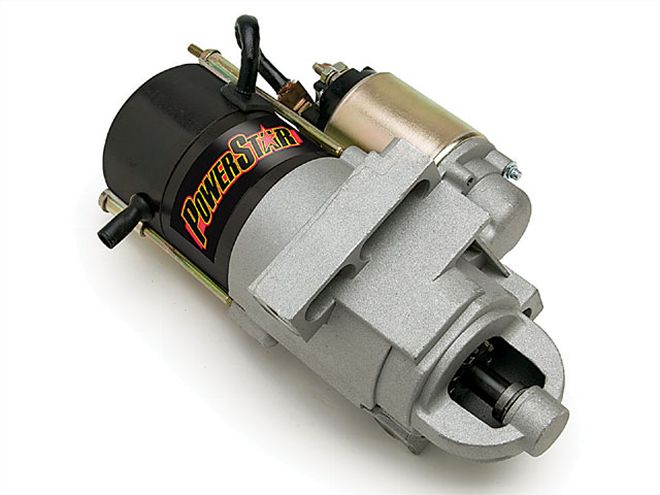 This isn't the sort of condition you should let your battery fall into. The scum on top could cause a power drain, as current can seep through it from one terminal to the other.
This isn't the sort of condition you should let your battery fall into. The scum on top could cause a power drain, as current can seep through it from one terminal to the other.
Next up is CCA, or cold cranking ability. This is the number of amps a battery can support for 30 seconds at zero degrees Fahrenheit. A 12V battery with a 600-CCA rating means the battery will provide 600 amps for 30 seconds at zero before becoming unusable. Reserve capacity, or RC, is the third rating, and indicates how many minutes the battery is able to power your vehicle's electrical system if the alternator fails. As hot rodders, we like to go by the philosophy that bigger is better, and in general, the higher the number for CCA and RC the better, though in cold climates a higher CCA rating is more important than in a warm environment. The various battery manufacturers issue charts from which you can select a battery suitable for your car, though obviously these don't include "our" sort of cars; but as an example we used the Optima battery web site to select a battery for a '92 Camaro, reasoning it was V-8 powered and didn't need to run as many electrical systems as a newer car. The figures came out as CCA 720, RC 90, and amp hour 44. The figures for a 1960 Ford Falcon were identical, but search for a 2005 Escalade and the figures jump to 800, 110, and 50, respectively, as more electrical systems need more power.
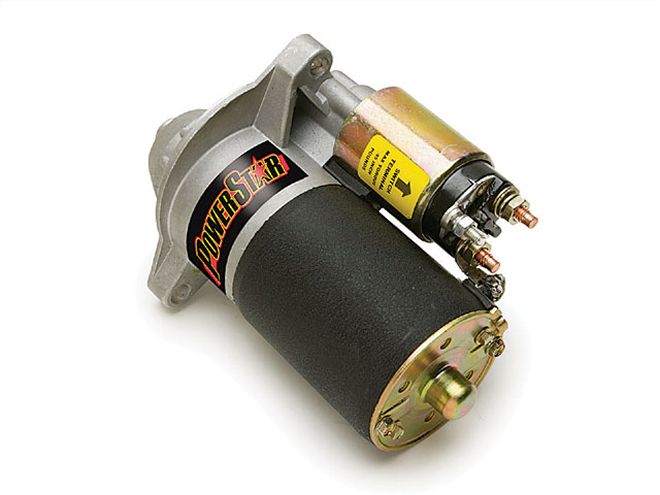
Starter motor
Certainly the largest current draw your electrical system will have to contend with is the starter motor, but for obvious reasons it only draws current for a short time, or at least it should! With a typical draw of 350 amps, it's easy to see why a battery will drain in short order with continued cranking. As the starter circuit draws a high amperage, it stands to reason that the components in that circuit are highly stressed for short periods, meaning the battery, its terminals, the cables, remote solenoids, and kill switches, if fitted, generate high resistance under load, and should be in top condition.
Wiring
Wiring a project is (depending on your point of view, of course) a necessary chore along with upholstery, body and paintwork, or even engine building for some. However, it is right up there on the list of things most people don't want to tackle. But given the array of wiring harnesses (both dedicated and universal) available from the aftermarket these days, it shouldn't be that hard to accomplish, should it? However, this isn't about installing a wiring harness, though if you're wiring from scratch, you'll need to know what gauge wire to use for various components, as a higher current draw will require wire rated to handle that current.
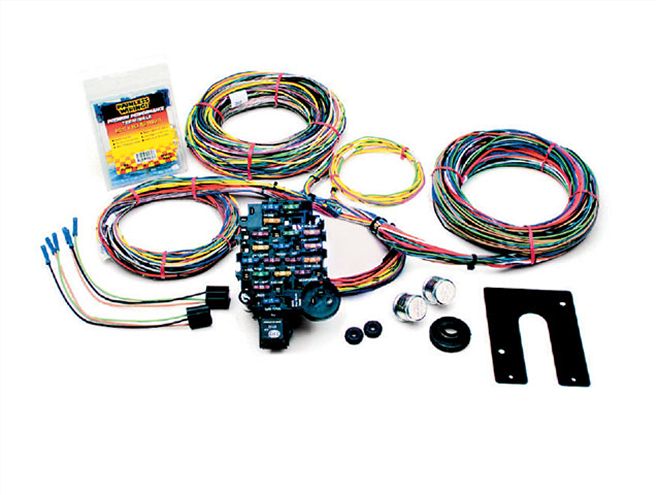
We spoke to the guys at painless performance about exactly that, because, in addition to wiring kits, the company supplies wire stock. The first thing they told us was that there's a huge difference in the quality of wire you can buy from automotive supply houses and specialist wiring manufacturers. For instance, you may buy a roll of 12-gauge wire from your local auto parts store that's rated at 35A, whereas painless performance's wire rated at the same amperage will be 14-gauge. Their wiring kits will contain wires ranging from 8-gauge up to 18-gauge, depending on the current draw of individual components. For instance, 10-gauge wire will be used from the fuse box to the battery or alternator, 12-gauge from the fuse box to the ignition, 14-gauge to the headlights, and 16- or 18-gauge to the gauges.
But there's another factor to add into the equation, and that's the length of the wire. Painless recommends going down numerically by one gauge size for long runs of 10 feet or more-for instance, from the front to back of a car, as the longer the wire, the more resistance it generates, thus drawing more current. The chart below shows what gauge to select for different applications and current draws, but it's intended as a rough guide owing to differences in manufacturers' wiring. It should also be noted that ground cables need to be the same gauge as or thicker (lower number gauge) than positive cables, as they carry the same current as the feed wire.
Wire Gauge Chart Gauge Amperage Applications 10 55 fuse box to alternator and battery 12 40 fuse box to ignition 14 35 headlights, power windows, and locks 16 22 taillights 18 16 gauges
Increasing the Load
Adding power windows, seats, and door locks, door poppers, A/C and heat, or a stereo all increase the current draw, and it's just not going to cut it with a number of extra systems if your system is running a 60-amp alternator. However, it's not necessary to add all the amperage requirements together to get an idea of your vehicle's required supply, as components such as power windows, seats, and locks will only be used for a short amount of time. For your information, the folks at Electric-Life told us their power windows will draw 8 amps (maximum), with the solenoids in their shaved handle kits drawing a maximum of 12 amps each when magnetized.
Just total the systems that will run for more than a few seconds, or permanently. One such system would be air conditioning. We spoke with Rick Love at Vintage Air, who told us a typical A/C system will draw 20-23 amps for the blower at "high blow," plus the clutch will draw another 3-4 amps. Then, although strictly not part of the A/C system, a good electric fan (which is required to blow air through the condenser) will pull something in the 18-25-amp range. So you can see how the current draw starts to add up quickly.
We haven't even mentioned a halfway decent stereo system, and the huge draw amplifiers can pull. A simple powered CD player will usually draw around 15 amps, but there's so much more to the vast range and complexity of entertainment systems-and that includes DVD players, satellite navigation, and game players as well as stereos-that we'll leave that particular can of worms for you to open with your car audio installer!